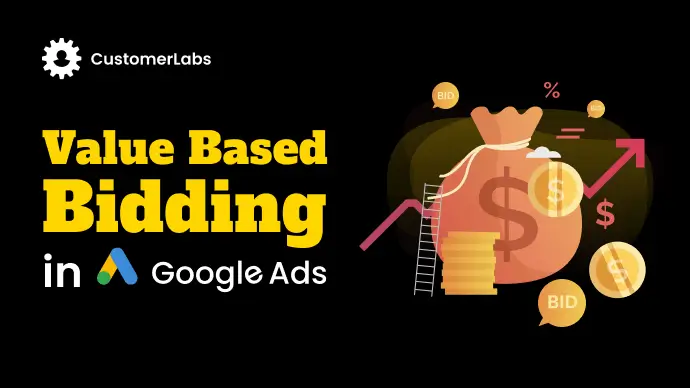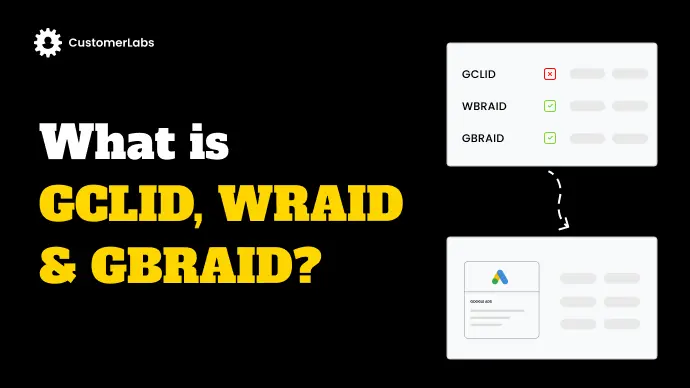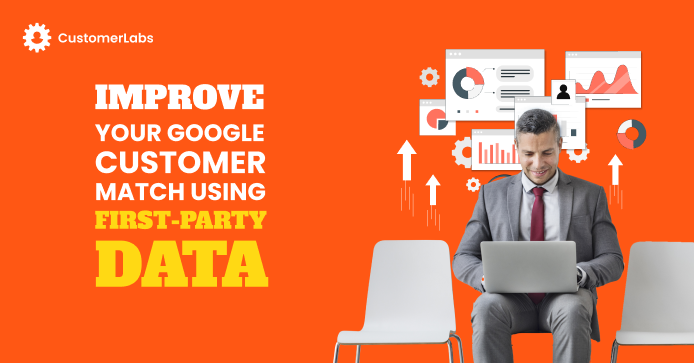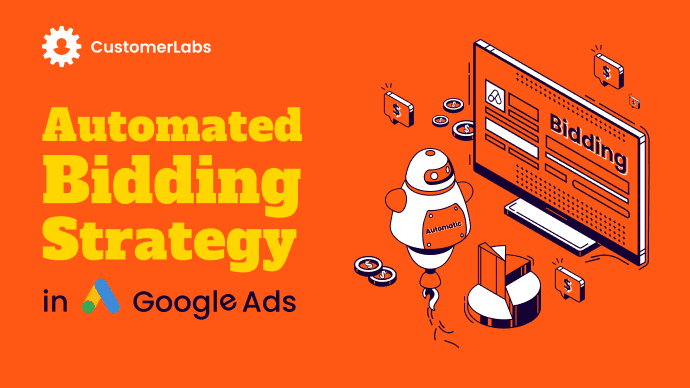
Will automation, artificial intelligence, and machine learning algorithms supplement your manual bidding strategy in Google Ads?
Most marketers are in a dilemma because they feel there is a lack of control over their ad campaigns when they go with automated bidding.
Let’s know today through this blog in detail about automated bidding, types of automated bidding strategies, which automated bidding strategy suits your business, and how to leverage it to your advantage.
So, let’s start by knowing what it actually is.
What is Automated Bidding in Google Ads
Automated bidding is the evolution of bidding from a manual bidding process to a fully automated process.
When it comes to automated bidding strategy, you need not change the bid value manually. The algorithm understands the performance of the specific keyword and accordingly assigns the bid value by analyzing the historical data to increase the chances of the target audience to click on that ad or fulfill the action required.
All you have to do is to give your budget, the desired goal/objective to be achieved and the required boundaries. You can input the traits of the target audience to help the ad platform to understand whom you want to show your ad.
In automated bidding, the crucial part is giving the right data to the ad platform. When you give better quality first-party data to Google ads, the ad platform’s algorithm learns the audience signals faster and optimizes the bid value in less time.

To know how automated bidding is different and advanced, you need to know a little bit about manual bidding as well.
So, in manual bidding, you need to assign a bid value for every single keyword manually. If there are 500 keywords, you have to spend time on assigning the bid value for every single keyword. You have to monitor its performance and change the bid value accordingly either hourly, daily, or weekly, depending on your choice.
Automated Bidding & Smart Bidding: What’s the difference?
The smart bidding strategy was launched by Google Ads recently and is a part of the automated bidding strategy. In short, smart bidding is an advanced automated bidding.
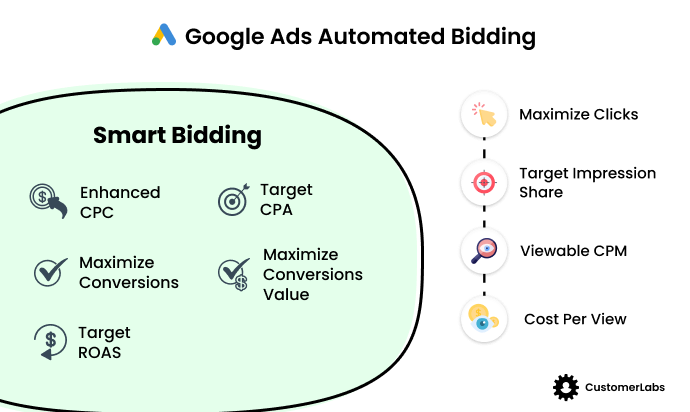
In smart bidding, the ad platform uses AI and machine learning algorithms to realize your specific goal. The goal can be either maximizing conversions or maximizing conversion value using auction-time bidding.
While automated bidding just automates the entire bidding process, smart bidding goes a step further and plays around with target CPA, target ROAS, and getting maximum conversions or maximum conversion value.
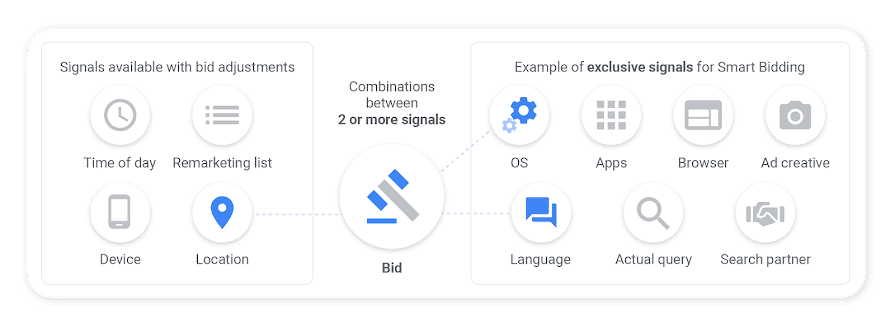
Types of Automated Bidding Strategies
There are in total nine types of automated bidding strategies of which two can be clubbed into one. That gives a total of eight automated bidding strategies. Below are the automated bidding strategies available on Google Ads
- Enhanced cost per click (ECPC)
- Maximize clicks
- Maximize conversions
- Target cost per action ( tCPA)
- Value-based bidding
- Maximize conversion value
- Target return on ad spend (tROAS)
- Viewable CPM (vCPM)
- Cost per view (CPV)
- Target impression share
Of the above eight automated bidding strategies, eCPC, maximize conversions, tCPA, maximize conversion value & tROAS, are smart bidding strategies.
Let us discuss in detail about every single automated bidding strategy and understand how it helps your ad campaigns.
1. Enhanced Cost Per Click (ECPC)
If you were doing manual cost-per-click (CPC) bidding, you will have to adjust the bid value manually. In enhanced CPC, the smart bidding strategy, that hectic job and great responsibility is taken off you by Google’s automated bidding. It is a hybrid mode wherein you have control over the bids and Google also automatically adjusts the bids based on auction-time signals. These signals include device, browser, location, and time.
In the ECPC bid strategy, the ad algorithm will customize the bids for every single search every single time. Here you set the maximum CPC manually first. After that, when the ad is in the auction-time Google adjusts the bid value automatically to get an average CPC that is less than the max CPC.
However, if you wish to make adjustments to this bid value, you can make it. Your adjustments will be applied over Google’s automated adjustments. Thus, you have full control of your ad campaigns.
2. Maximize clicks
The maximize clicks automated bidding strategy helps you increase your website visits. As the name suggests, it delivers the maximum clicks possible from the search engine results page.
The ad platform’s algorithm gives you two choices:
- Set the maximum cost per click you would like to have,
- Let the algorithm bid as much as it wants to get the maximum clicks possible within your ad budget.
The Google Ads’ algorithm activates the second option by default when you do not give the maximum cost you can afford per click.
3. Maximize conversions
The maximize conversions bid strategy is a type of smart bidding strategy that will get you as many conversions as possible for the set budget.
Real-time data is used by the ad algorithm to optimize the campaigns set up with maximize conversions as a bid strategy.
If you have any existing bid adjustments in place, they are negated as soon as you shift to the maximize conversions bid strategy. However, note that the ad algorithm customizes every auction to achieve the least possible cost per conversion.
4. Target Cost Per Action (tCPA)
The target cost per action or the tCPA bid strategy was earlier available as a standalone bid strategy. However, now it is clubbed inside the Maximize Conversions bid strategy. After you choose the maximize conversions bid strategy, you will be able to check the tCPA box and enter the tCPA you need.
First, you have to tell the ad platform that you want to focus on the conversions and then, you limit it using the target CPA. It looks like below.
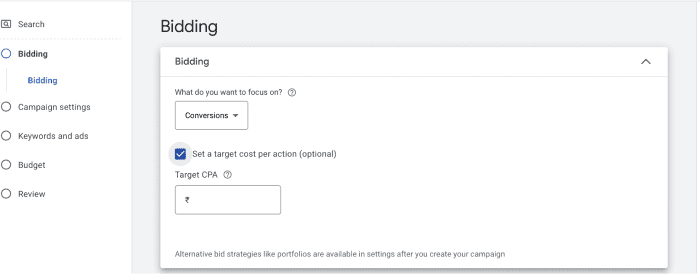
You should assign the target CPA based on the average of historical average CPA which you will get through the bid strategy report.
Note: Ensure to give the target CPA as realistic as possible for the algorithm to learn better and deliver better results. Giving a tCPA that is highly assumed and impractical will lead to low performance of your ad campaigns.
5. Value-based bidding
In the value-based bidding strategy, you will let the ad algorithm bid based on the conversion value i.e., the value a certain conversion brings to your business rather than bidding the same bid value for all conversions.
When you run an ad campaign, there might be some conversions that might bring high value to your business and then there are conversions that bring less value to your business. So, in the value-based bidding strategy, you bid based on the value creation.
Under the purview of value-based bidding, there are two bidding strategies:
- Maximize Conversion Value
- Target ROAS
Maximize Conversion Value
The maximize conversion value bid strategy maximizes the total conversion value of your ad campaign by spending your full budget. The ad platform’s algorithm will have only one goal in its way – achieving maximum conversion value.
The maximum conversion value bid strategy makes use of advanced machine learning technology to automate the bid optimization process in real time and set the right bid value.
You can control how frequently your ad appears based on how people are searching at what time and from where.
Target ROAS
The target Return on Ad Spend (ROAS) or the tROAS bid strategy is a subset of the maximize conversion value bid strategy. To use the tROAS, you have to select the maximum conversion value as the bid strategy and then check the box that says target ROAS.
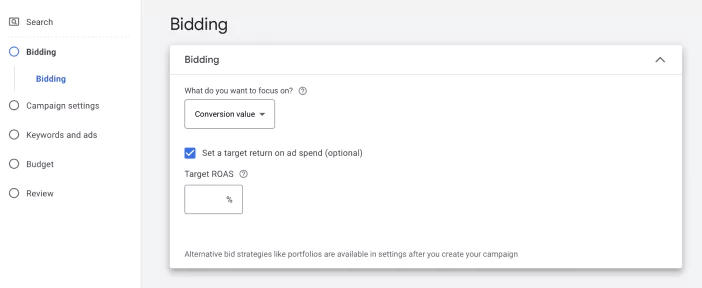
Caution: Before you set up target ROAS, wait until you received at least 15 conversions in the last 30 days. To know more about how long to wait before you, check out our blog on value based bidding.
This is how you choose the tROAS bid strategy.
Note: Ensure to set the realistic ROAS. If unsure what ROAS you should expect, check your bid strategy report for the historical average ROAS and use that value. If in case you give a higher ROAS, the ad algorithm will fail to increase your ad campaign performance.

6. Viewable CPM
Viewable CPM or the cost per thousand viewable impressions is an automated bidding strategy that costs you only after the
- target audiences’ screen shows 50% of the Display Ad for a second or more
- Video ad plays continuously for more than or equal to two seconds
It is an advanced version of CPM (cost per thousand impressions) and Google has mentioned that the viewable CPM bid strategy will replace the existing CPM bid strategy and Max. CPM is no longer available as a bid strategy.
7. Cost Per View (CPV)
CPV is a bid strategy that is available only for video ad campaigns. In this bid strategy, you pay only when a viewer
- Views your ad for a minimum of 30 seconds (unless your ad duration is less than 30 seconds), or
- Interacts with your ad
This is an automated bidding strategy because Google Ads will consider the maximum cost per view bid and limit the spend per view. However, it is not always the case. Based on your Ad rank, Ad quality, user preference, and other contextual signals, the ad algorithm will automatically try to achieve the least possible cost per view, which is the actual CPV.
8. Target Impression Share
The target impression share is a unique automated bidding strategy that will let you choose where you want to place your ad precisely, for a particular key term. Target impression share offers three placements for your ads.
- Absolute Top
- Top
- Anywhere on the search page
Google Ads launched the target impression share strategy in late 2018.
In the target impression share bid strategy, Google Ads gives you the choice to set an impression share target. Let’s understand this with an example. Let us say you have set the impression share target as 70% for absolute top placement.
Now, Google Ads will try to bid automatically to show your ad in the first position (the absolute top) in 70% of its auctions. Therefore, in this automated bidding strategy, you can be sure to pay for the right position which you feel is worth it.
Setting up Automated Bidding Strategies like a Pro
You have known about the various automated bid strategies available. But the question arises, how do you actually set up the bidding strategy?
There are two ways you can go for automated bidding strategies.
- Changing the bidding strategy for existing campaigns;
- Going for the automated bidding strategy from the start of the campaign.
1. Assuming that you are already running a few campaigns and want to change that Bid Strategy
Below are the steps to modify the bid strategy of an existing ad campaign.
1: Click on any of your existing campaigns
2: Go to Settings (on the right side)
3: Click Bidding on the main screen
4: Click on the ‘change bid strategy’
5: Choose the bidding of your choice (the bidding strategy that most suits your need)
6: Choose any other options, if relevant and finally click on ‘Save’
You can choose any of the bidding strategies mentioned above. However, you will find only four major bid strategies. To unleash the other four automated bid strategies, you have to choose from Conversions, Conversion Value, Clicks & Impression share, and then select the options within them leading to the other bid strategies.
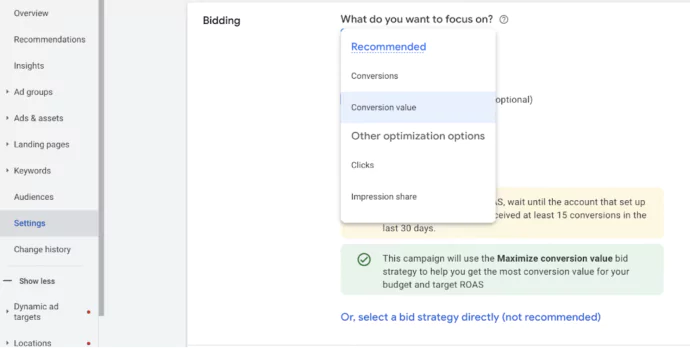
Recommendation: set up conversions before setting up a campaign.
2. Creating an ad campaign from the start
Step 1: Click the + on the Google Ads home page to start a new campaign
Step 2: Choose your goal. (If you do not have any goal, choose ‘create a campaign without the goal guidance’)
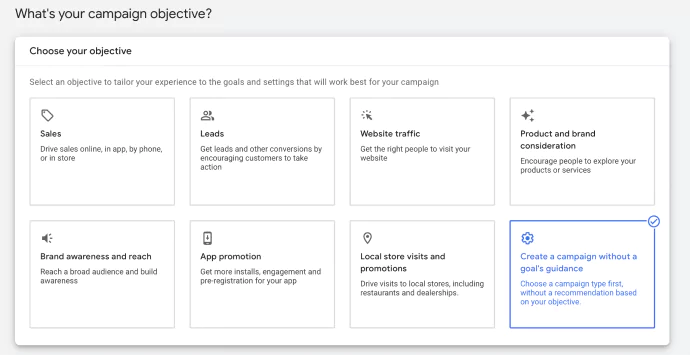
Step 3: Next select the campaign type. Here’s where you have to carefully choose the campaign type that suits your objectives
Follow the subsequent steps and continue to land on the bidding strategy page.
Based on the campaign type you select, your next steps would change. Come up with your own strategies and campaigns that you want to run for your target audience.
Which Automated Bidding Strategy suits the Best for your Business?
All these automated bid strategies serve a single purpose. They focus on one thing and achieve it for you. Therefore, you should know which bid strategy works best for your business. Once decided you can launch your campaign with that bidding strategy to reach the required goal.
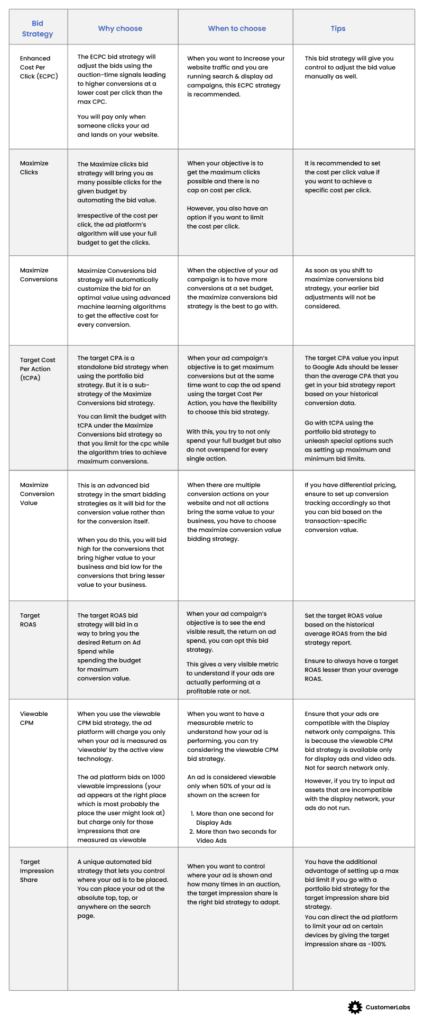
Portfolio Bid Strategy
When you are running multiple campaigns with the same bidding strategy, it is recommended to go with the portfolio bid strategy because
- Easy to manage multiple campaigns in one place
- You can unlock advanced options that are available only with the portfolio bid strategy.
- The ad platform has more data to learn
- Better optimization of ad campaigns
What is a portfolio bid strategy?
It is a type of automated bid strategy that has a specific goal for multiple campaigns at once by grouping all of them.
Below is the screenshot of all the available smart bidding strategies that you can choose when you want to go with a portfolio bid strategy.
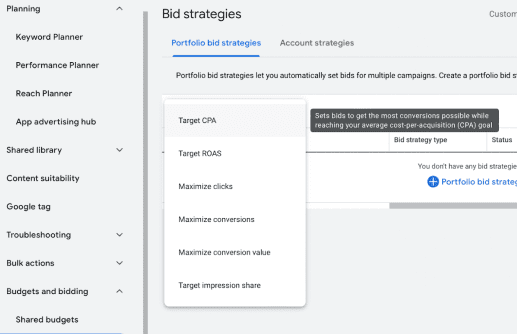
You can see that Target CPA, Target ROAS, Maximize Clicks, Maximize Conversions, Maximize Conversion Value, & Target Impression Share are all the available bid strategies under the portfolio bid strategies.
How to set up a Portfolio bid strategy?
Please note that the interface of Google Ads is slowly changing. Here you’ll be seeing the latest interface of Google Ads and how you can set up the portfolio bid strategy.
Click Tools on the left, navigate to Budgets and Bidding, and click on Bid Strategies to go to Portfolio bid strategies. Here, click on + to create a new portfolio bid strategy.
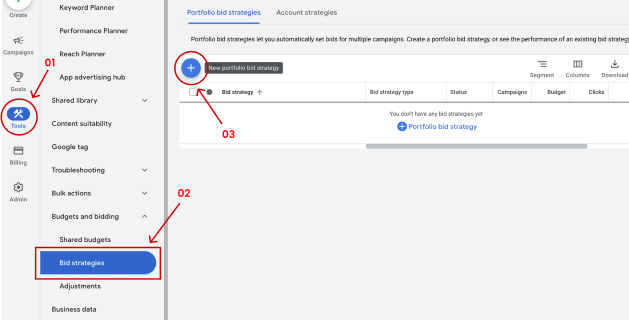
Choose the strategy that you have decided to go with from Target CPA, Target ROAS, Target Impression Share, Maximize Clicks, Maximize Conversions & Maximize Conversion Value.
You have the option to set the maximum bid limits for tCPA, tROAS & target impression share bid strategies only when you use portfolio bid strategy. You can also set the minimum bid limit for tCPA & tROAS.
There is an option to share your budget across multiple campaigns using the portfolio bid strategy.
When you are using the portfolio bid strategy, the ad platform has more data in a short time. This helps the ad platform learn faster and optimize the ad campaigns for better results quickly.
Conclusion and Key Takeaways:
Automated bidding strategies save you time by automating the entire bidding process. Now you can fully focus on running your ad campaigns effectively to achieve the desired results. To adapt to the ever-changing dynamics of the market by incorporating real-time changes, adopt the automated bidding strategies now. Here are a few key takeaways from this automated bidding strategies blog:
Lack of Control:
With automated bidding strategies, the level of control the marketer had in the manual bidding process is unavailable. Automation takes the place of the manual bidding process, giving very less control to the marketer to control the bid value.
Time taking:
It takes time for the automated bid strategy to work effectively as the ad algorithm needs sufficient duration and data to learn and optimize. Because of this, the ad platform tends to spend budgets more than what you used to spend earlier in manual bidding.
Minimize Human Errors:
There is a slight probability of errors popping up during the manual bidding process. You can eliminate the possibility of error with automated bidding.
Ever-learning algorithm:
In automated bidding, the ad platform’s algorithm learns and updates itself about the bid’s performance to help you for future bids. Therefore, the ad algorithm will choose the optimal bid value for all future bids.
Auction-time bidding:
The smart bidding strategy, the subset of the automated bidding strategy, uses auction-time bidding for every single search. It is based on the auction-time signals such as device, browser, operating system, time, location, remarketing list (first-party data), and language.
Goal-driven bidding:
You can fix a goal for a certain campaign with the automatic bidding strategy and the ad platform’s algorithm will focus only on achieving the goal. Be it maximum conversions, increase website traffic, increase visibility, increase conversion value or achieve a desired ROAS.
The automated bidding strategies are to be set up properly and given sufficient time to run. In the case of maximize conversion value bidding strategy, Google recommends to wait a minimum of six weeks to analyze the ad campaign performance.
Similarly, for all the automated bidding strategies, you should set up and test to learn how the bid strategies are working for your business. Keep experimenting with different automated bid strategies, compare the ad campaign performance over a prolonged duration, and then decide which bid strategy works for your business and which does not.
You have understood in detail about the various automated bidding strategies and which type of bidding strategy suits your business. Carefully analyze and decide the right bidding strategy for your business. Leverage the complete benefits of automated bidding strategies to stay in the race.

